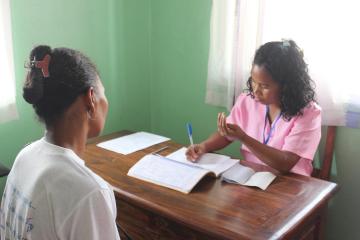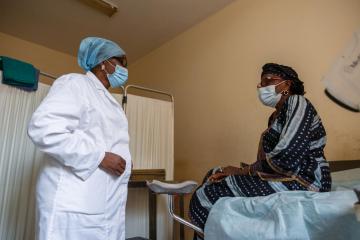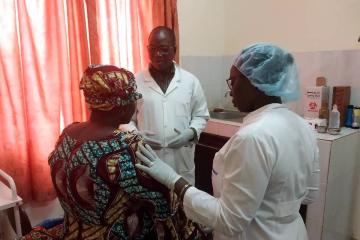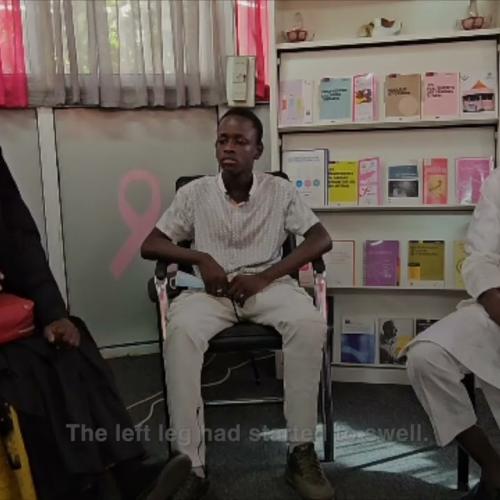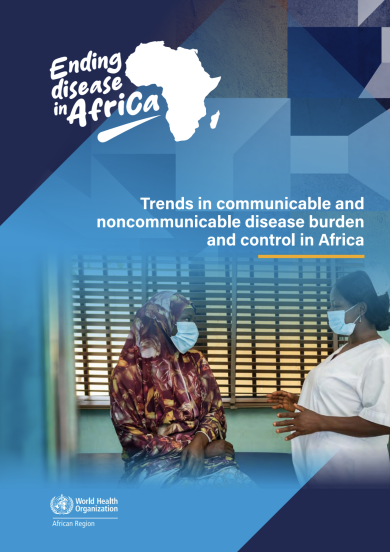Factsheet
Key Facts
- Cancer is one of the leading causes of morbidity and mortality worldwide, with approximately 14 million new cases in 20121.
- The number of new cases is expected to rise by about 70% over the next 2 decades.
- Cancer is the second leading cause of death globally, and was responsible for 8.8 million deaths in 2015. Globally, nearly 1 in 6 deaths is due to cancer.
- Approximately 70% of deaths from cancer occur in low- and middle-income countries.
- Around one third of deaths from cancer are due to the 5 leading behavioral and dietary risks: high body mass index, low fruit and vegetable intake, lack of physical activity, tobacco use, and alcohol use.
- Tobacco use is the most important risk factor for cancer and is responsible for approximately 22% of cancer deaths.2.
- Cancer causing infections, such as hepatitis and human papilloma virus (HPV), are responsible for up to 25% of cancer cases in low- and middle-income countries3.
- Late-stage presentation and inaccessible diagnosis and treatment are common. In 2015, only 35% of low-income countries reported having pathology services generally available in the public sector. More than 90% of high-income countries reported treatment services are available compared to less than 30% of low-income countries.
- The economic impact of cancer is significant and is increasing. The total annual economic cost of cancer in 2010 was estimated at approximately US$ 1.16 trillion4.
- Only 1 in 5 low- and middle-income countries have the necessary data to drive cancer policy5.
Cancer is a generic term for a large group of diseases that can affect any part of the body. Other terms used are malignant tumours and neoplasms. One defining feature of cancer is the rapid creation of abnormal cells that grow beyond their usual boundaries, and which can then invade adjoining parts of the body and spread to other organs, the latter process is referred to as metastasizing. Metastases are a major cause of death from cancer.
Cancer is a leading cause of death worldwide, accounting for 8.8 million deaths in 2015. The most common causes of cancer death are cancers of:
- Lung (1.69 million deaths)
- Liver (788 000 deaths)
- Colorectal (774 000 deaths)
- Stomach (754 000 deaths)
- Breast (571 000 deaths)
Cancer arises from the transformation of normal cells into tumour cells in a multistage process that generally progresses from a pre-cancerous lesion to a malignant tumour. These changes are the result of the interaction between a person's genetic factors and 3 categories of external agents, including:
- physical carcinogens, such as ultraviolet and ionizing radiation;
- chemical carcinogens, such as asbestos, components of tobacco smoke, aflatoxin (a food contaminant), and arsenic (a drinking water contaminant); and
- biological carcinogens, such as infections from certain viruses, bacteria, or parasites.
WHO, through its cancer research agency, International Agency for Research on Cancer (IARC), maintains a classification of cancer-causing agents.
Ageing is another fundamental factor for the development of cancer. The incidence of cancer rises dramatically with age, most likely due to a build-up of risks for specific cancers that increase with age. The overall risk accumulation is combined with the tendency for cellular repair mechanisms to be less effective as a person grows older.
Tobacco use, alcohol use, unhealthy diet, and physical inactivity are major cancer risk factors worldwide and are also the 4 shared risk factors for other noncommunicable diseases.
Some chronic infections are risk factors for cancer and have major relevance in low- and middle-income countries. Approximately 15% of cancers diagnosed in 2012 were attributed to carcinogenic infections, including Helicobacter pylori, Human papillomavirus (HPV), Hepatitis B virus, Hepatitis C virus, and Epstein-Barr virus3.
Hepatitis B and C virus and some types of HPV increase the risk for liver and cervical cancer, respectively. Infection with HIV substantially increases the risk of cancers such as cervical cancer.
Between 30–50% of cancers can currently be prevented. This can be accomplished by avoiding risk factors and implementing existing evidence-based prevention strategies. The cancer burden can also be reduced through early detection of cancer and management of patients who develop cancer. Many cancers have a high chance of cure if diagnosed early and treated adequately.
Modifying or avoiding key risk factors can significantly reduce the burden of cancer. These risk factors include:
- tobacco use including cigarettes and smokeless tobacco
- being overweight or obese
- unhealthy diet with low fruit and vegetable intake
- lack of physical activity
- alcohol use
- sexually transmitted HPV-infection
- infection by hepatitis or other carcinogenic infections
- ionizing and ultraviolet radiation
- urban air pollution
- indoor smoke from household use of solid fuels.
Tobacco use is the single most important risk factor for cancer and is responsible for approximately 22% of cancer-related deaths globally2.
To prevent cancer, people may:
- increase avoidance of the risk factors listed above;
- vaccinate against HPV and hepatitis B virus;
- control occupational hazards;
- reduce exposure to ultraviolet radiation;
- reduce exposure to ionizing radiation (occupational or medical diagnostic imaging).
Vaccination against these HPV and hepatitis B viruses could prevent 1 million cancer cases each year3.
Cancer mortality can be reduced if cases are detected and treated early. There are 2 components of early detection:
Early diagnosis
When identified early, cancer is more likely to respond to effective treatment and can result in a greater probability of surviving, less morbidity, and less expensive treatment. Significant improvements can be made in the lives of cancer patients by detecting cancer early and avoiding delays in care.
Early diagnosis consists of 3 steps that must be integrated and provided in a timely manner:
- awareness and accessing care
- clinical evaluation, diagnosis and staging
- access to treatment.
Early diagnosis is relevant in all settings and the majority of cancers. In absence of early diagnosis, patients are diagnosed at late stages when curative treatment may no longer be an option. Programmes can be designed to reduce delays in, and barriers to, care, allowing patients to access treatment in a timely manner.
Screening
Screening aims to identify individuals with abnormalities suggestive of a specific cancer or pre-cancer who have not developed any symptoms and refer them promptly for diagnosis and treatment.
Screening programmes can be effective for select cancer types when appropriate tests are used, implemented effectively, linked to other steps in the screening process and when quality is assured. In general, a screening programme is a far more complex public health intervention compared to early diagnosis.
Examples of screening methods are:
- visual inspection with acetic acid (VIA) for cervical cancer in low-income settings;
- HPV testing for cervical cancer;
- PAP cytology test for cervical cancer in middle- and high-income settings; and
- mammography screening for breast cancer in settings with strong or relatively strong health systems.
A correct cancer diagnosis is essential for adequate and effective treatment because every cancer type requires a specific treatment regimen that encompasses one or more modalities such as surgery, radiotherapy, and chemotherapy. Determining the goals of treatment and palliative care is an important first step, and health services should be integrated and people-centred. The primary goal is generally to cure cancer or to considerably prolong life. Improving the patient's quality of life is also an important goal. This can be achieved by supportive or palliative care and psychosocial support.
Some of the most common cancer types, such as breast cancer, cervical cancer, oral cancer, and colorectal cancer have high cure rates when detected early and treated according to best practices.
Some cancer types, even when cancerous cells have traveled to other areas of the body, such as testicular seminoma and leukaemias and lymphomas in children, can have high cure rates if appropriate treatment is provided.
Palliative care is treatment to relieve, rather than cure, symptoms caused by cancer and improve the quality of life of patients and their families. Palliative care can help people live more comfortably. It is an urgent humanitarian need for people worldwide with cancer and other chronic fatal diseases and particularly needed in places with a high proportion of patients in advanced stages of cancer where there is little chance of cure.
Relief from physical, psychosocial, and spiritual problems can be achieved in over 90% of advanced cancer patients through palliative care.
Effective public health strategies, comprising of community- and home-based care are essential to provide pain relief and palliative care for patients and their families in low-resource settings.
Improved access to oral morphine is mandatory for the treatment of moderate to severe cancer pain, suffered by over 80% of cancer patients in terminal phase.
n 2013, WHO launched the Global Action Plan for the Prevention and Control of Noncommunicable Diseases 2013-2020 that aims to reduce, by 25%, premature mortality from cancer, cardiovascular diseases, diabetes, and chronic respiratory diseases by 2025.
WHO and IARC collaborate with other UN organizations within the UN Interagency Task Force on the Prevention and Control of Noncommunicable Diseases and partners to:
- increase political commitment for cancer prevention and control;
- coordinate and conduct research on the causes of human cancer and the mechanisms of carcinogenesis;
- monitor the cancer burden (as part of the work of the Global Initiative on Cancer Registries);
- identify priority strategies for cancer prevention and control;
- generate new knowledge and disseminate existing knowledge to facilitate the delivery of evidence-based approaches to cancer control;
- develop standards and tools to guide the planning and implementation of interventions for prevention, early diagnosis, screening, treatment and palliative and survivorship care;
- facilitate broad networks of cancer control partners and experts at global, regional and national levels;
- strengthen health systems at national and local levels to deliver cure and care for cancer patients;
- provide global leadership as well as technical assistance to support governments and their partners build and sustain high-quality cervical cancer control programmes; and
- provide technical assistance for rapid, effective transfer of best practice interventions to less-developed countries.
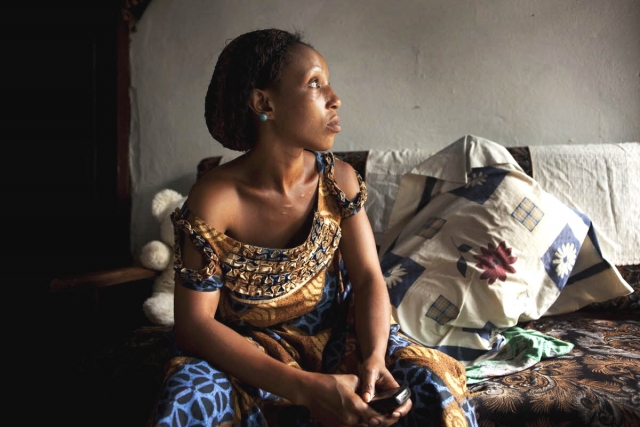
Cervical cancer is caused by the sexually transmitted human papillomavirus (HPV), which is the most common viral infection of the reproductive tract. It affects younger age groups as a result of early sexual activity, multiple sexual partners, and exposure to other sexually transmitted infections such as HIV.
There are more than 100 types of HPV, of which at least 13 are cancer-causing. Two types of HPV cause 70% of all cervical cancer. Most sexually active men and women will be infected at some point in their lives with HPV – some may be repeatedly infected.
The World Health Organization (WHO) estimates HPV infections cause approximately 68 000 cases of cervical cancer each year in Africa. However, these figures most likely represent a conservative estimate due to the health challenges in health information systems and cancer registries in the Region.
Cervical cancer is a preventable disease. Yet it is the most common cause of cancer in the African Region where it accounts for 22% of all female cancers and 12% of all newly diagnosed cancer in both men and women every year. In Africa, 34 out of every 100 000 women are diagnosed with cervical cancer and 23 out of every 100 000 women die from cervical cancer every year.
This figure compares with 7 out of every 100 000 women being diagnosed with cervical cancer and 3 out of every 100 000 women dying of the disease every year in North America. In Africa, most of these women are diagnosed at advanced stage of cancer which is associated with poor outcomes.
There is a safe and very effective vaccine that protects against HPV and it has the potential to prevent one third of all cases of cervical cancer. Two HPV vaccines are certified safe by WHO and are intended for use in girls between age 9 and 13 years. The vaccine produces the highest immune response at this age and it is important to receive the vaccine before exposure to HPV.
Routine cervical cancer screening and early treatment can prevent up to 80% of cervical cancers if abnormali-ties of the cervix are identified at stages when they can be easily treated. WHO recommends screening for all women aged 30–49 years to identify precancerous lesions, which are usually asymptomatic. HPV vaccination is vital but does not replace the necessity of cervical cancer screening and early treatment in women.
It is very important that all women in the target age group are screened, irrespective of their HPV vaccination status, and treated if precancerous lesion is identified. The vast difference in cervical cancer incidence in developing versus developed countries is a reflection of the absence of national cervical cancer screening and treatment programmes in majority of developing countries.
In many parts of Africa, cervical cancers are not identified or treated until advanced stages due to insufficient access to reproductive health care services, effective screening and early treatment.
Approximately one third of all cancers can be prevented. This highlights the importance of legislative and regulatory measures, as well as health promotion interventions that advocate for HPV vaccination, improved access to physical activity and healthy diet, and against tobacco and the harmful use of alcohol.
“Cervical cancer is a preventable disease and affects far too many women in the African Region. There is an urgent need to integrate cancer control programmes into existing primary sexual and reproductive health care services, strengthen multisectoral collaboration, and improve public health awareness in order to tackle this devastating disease,” said Dr Matshidiso Moeti, WHO Regional Director for Africa.
Strategies to address cervical cancer and achieve treatment for all need to deal with health inequities that arise from the societal conditions in which women are born, grow, live and work to mitigate barriers to childhood development, education, employment, housing and environment. They also need to address cultural and socioeconomic factors that negatively affect cancer screening, early detection and care.
In order to reduce the cervical cancer burden in the African Region, WHO will continue to support Ministries of Health to implement priority cancer prevention and control interventions that cuts across the continuum of prevention, early detection, diagnosis, treatment and palliative care services.
___________________________
For more information, please contact:
Technical contact:
Dr Prebo Barango, Tel: +472 413 8033; Email: barangop@who.int
Media contact:
Dr Cory Couillard, Tel: + 472 413 9995; Email: couillardc@who.int




